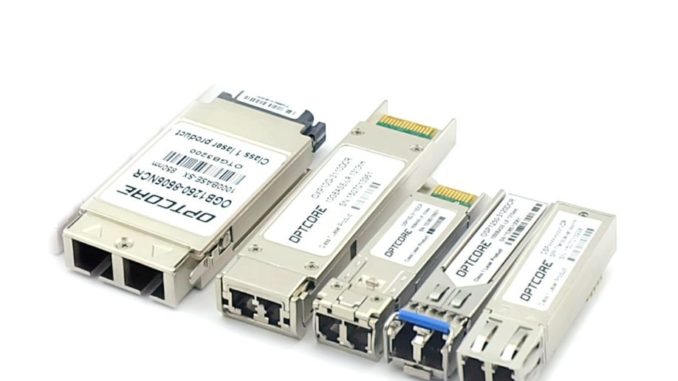
GBIC, SFP, SFP+, and XFP are all terms for a type of transceiver optics that plugs into a special port on a switch, router or other network devices to convert the port to a copper or fiber interface. The commonly used SFP, SFP+, and XFP are all with LC connector. SFP and SFP+ with an identical pinout that is different with XFP transceivers. Both SFP+ and XFP with DDM function as a default, whereas SFP partly supports DDM function.
Comparison: SFP vs GBIC vs SFP+ vs XFP
| Optics Type | Standard | Data Rate | Wavelength | Fiber Type | Max Distance | Typical Connector | DOM | Operating Temperature |
| SFP | SFP MSA | 155Mbps 622Mbps 1.25Gbps 2.125Gbps 2.5Gbps 3Gbps 4.25Gbps |
850nm 1310nm 1550nm CWDM DWDM BIDI |
OM1 OM2 OS1 OS2 |
160km | LC SC RJ-45 | No or Yes | Commercial Industrial |
| GBIC | GBIC MSA | 155Mbps 622Mbps 1.25Gbps |
850nm 1310nm 1550nm CWDM DWDM BIDI |
OM1 OM2 OS1 OS2 |
120km | SC RJ-45 | No | Commercial Industrial |
| SFP+ | IEE802.3ae SFF-8431 SFF-8432 |
6Gbps 8.5Gbps 10Gbps |
850nm 1310nm 1550nm CWDM DWDM BIDI Tunable Copper |
OM3 OM4 OS1 OS2 |
120km | LC | Yes | Commercial Industrial |
| XFP | IEE802.3ae XFP MSA |
6Gbps 8.5Gbps 10Gbps |
850nm 1310nm 1550nm CWDM DWDM BIDI Tunable Copper |
OM3 OM4 OS1 OS2 |
120km | LC | Yes | Commercial Industrial |
Figure 1 A Typical SFP SFP+ XFP Optics



SFP VS SFP+ (SFP Plus)
SFP and SFP+ with a similar form factor dimension hence look like the same.
SFP optics usually support 155Mb/s,1.25Gb/s to 4.25Gb/s while SFP+ ones supports data rates up to 8.5Gb/s and 10Gb/s.
SFP is for Fast Ethernet, Gigabit Ethernet,1x/2x/4x Fiber Channel, and SDH/SONET with data rate below 2.488Gb/s applications. SFP+ for 10 Gigabit Ethernet,10G SDH/SONET applications. SFP is compliant with IEEE802.3, INF-8074, and SFF-8472 while SFP+ is compliant with the protocol of IEEE 802.3ae, SFF-8431, SFF-8432.
XFP VS SFP+ (SFP Plus)
XFP is a separate standard that also supports 10Gb/s speeds for applications of 10 Gigabit Ethernet, 10 Gbit /s Fibre Channel, Synchronous optical networking (SONET) at OC-192 rates, Synchronous optical networking STM-64, 10 Gbit /s Optical Transport Network (OTN) OTU-2, and parallel optics links.4. The primary difference between SFP+ and the slightly older XFP standard is that SFP+ without the chip for clock and data recovery that makes an SFP+ smaller than an XFP, enabling greater port density. However, some SFP+ optics manufacturer like Optcore has developed SFP+ with CDR that for special applications. XFP is defined by XFP Multi-Source Agreement that is different with SFP+ MSA. Since SFP+ smaller dimension than XFP that provide a higher port density in switch and routers, nowadays it becomes more and more popular.